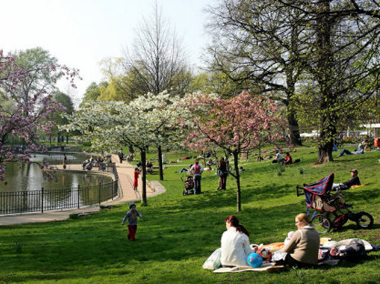A Touch of Green
 |
|
Small parks should provide easy access to nature, promote a more public daily life and foster a sense of intimacy that stimulates human interaction
|
ALBANY, N.Y. (November 7, 2016) — Even as populations worldwide continue to shift from rural to urban areas, spending time in nature remains instinctive within us.
For this reason, neighborhood-scale insertions such as small parks may be the basis for how nature is experienced by some city dwellers, "highlighting their importance within the urban fabric," says Geography and Planning Assistant Professor Melissa Anne Currie.
This idea motivated Currie, a licensed landscape architect, to study parks of three acres or less in a variety of settings in order to identify a common set of design principles that good public parks share, and which can be transferable beyond ultra-urban locations to smaller cities, towns or lower density suburban areas. Her results were published in the October issue of the Journal of Urban Design in the article "A design framework of small parks in ultra-urban, metropolitan, suburban and small town settings."
Small parks, she said, "provide nearby easy access to nature, promote a more public daily life and foster a sense of intimacy that stimulates human interaction," said Currie.
Interaction with nature is a particular challenge for residents of low-income urban communities who have lower rates of participation in nature-based recreation due to the inaccessible locations of many parks and open areas. "Low-income and minority populations typically have fewer transportation options — as do other vulnerable populations including youth and the elderly — making easily accessed and nearby public spaces extremely important," she said.
 |
|
Melissa Anne Currie |
New development of small parks, she wrote, "should create an environment where people interact with, rather than withdraw from one another and natural environments through a more public life." She notes that such development can lessen the disparity between wealthy and poor neighborhoods, "and address environmental justice issues by increasing neighborhood quality of life and aesthetics."
Opportunity exists in urban areas to add small parks to "built environments," she said. "Vacant or abandoned parcels create opportunities for new parks or community spaces to arise — something that is rare in the suburbs. . . . Homes in suburban development are on larger lots and all land in a subdivision is privately owned, including common areas such as community parks or recreation areas. In these situations, private parks are not open to the public and do not provide for interaction with those outside the specific neighborhood."
Development by post-World War II suburban planners operated on the assumption that singe-family detached homes in newly created, sprawling developments provided a private “park-like setting” in the form of front and back yards.
"This raises the question — do public parks still matter?," said Currie. "I argue they do, as private yards in subdivisions do not offer the benefits of social interactions that occur in public space. Nor do they provide the ecological functions or sustainable landscapes needed in developed areas."
Her five principles for a successful small urban park are:
- Accessibility — "This is perhaps the most important element of a small park — they must be where the people are," said Currie. Parks should be easily encountered in the course of the normal day’s routine . . . Too often, however, they are located as an afterthought or placed on a leftover or undesirable lot."
- Specificity — "There is a specific reason a design is appropriate in a specific location, allowing a symbiotic relationship to develop between the park and its users," said Currie. "Parks can be an expression of artistic variety and a celebration of an area’s uniqueness."
- Authenticity — A park must actually be the thing it is representing, not contrived or pre-prescribed — the downfall of some well-intended parks.
- Adaptability — As a living organism, a community is in perpetual motion, contracting and expanding with the rhythm of life. Small parks, embedded in this life form, must change and grow along with the neighborhood.
- Funtionality — A park must meet the specific needs of the surrounding community, such as active recreation facilities and sport programs for children.
These elements when combined, she found, are common to successful small parks regardless of the setting. She also noted that as a general framework they an be applied to community-university partnerships for low-income challenged urban neighborhoods, a topic of another of her recently published articles, "Challenges of building community-university partnerships in new poverty landscapes," in October's Community Development journal.
An accredited professional of the Congress of New Urbanism who came to UAlbany this fall, Currie's research interests include regional planning and how regions can transform themselves into a more sustainable model in which they are empowered to reverse decline and embrace the future.
![]() For more news, subscribe to UAlbany's RSS headline feeds
For more news, subscribe to UAlbany's RSS headline feeds
A comprehensive public research university, the University at Albany-SUNY offers more than 120 undergraduate majors and minors and 125 master's, doctoral and graduate certificate programs. UAlbany is a leader among all New York State colleges and universities in such diverse fields as atmospheric and environmental sciences, business, education, public health,health sciences, criminal justice, emergency preparedness, engineering and applied sciences, informatics, public administration, social welfare and sociology, taught by an extensive roster of faculty experts. It also offers expanded academic and research opportunities for students through an affiliation with Albany Law School. With a curriculum enhanced by 600 study-abroad opportunities, UAlbany launches great careers.


